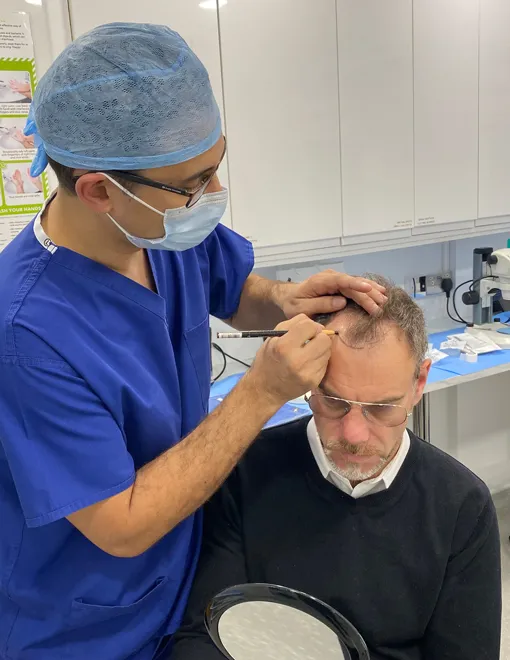Understanding Hair Thinning and Hair Loss
Hair thinning and hair loss, common concerns for many, often trigger anxiety and self-consciousness. While losing 50-100 hairs per day is normal due to the natural hair cycle, anything beyond this could indicate hair thinning. Causes range from genetics and hormonal changes to stress and medical conditions. But how can one differentiate between normal hair loss and a condition requiring attention?
Signs Your Hair Might Be Thinning
When suspecting hair thinning, there are several key indicators to watch for. A wider parting in your hair can be an early sign, as well as a more visible scalp, especially around the crown or hairline. An increase in hair fall, noticeable on your hairbrush, pillow, or shower drain, is a common red flag. Additionally, changes in your hair’s texture, such as it becoming finer or lacking its usual volume, can indicate thinning. These changes might not be abrupt but gradual, making it essential to observe them over a period to gauge their progression and severity accurately.
Differentiating Between Normal Hair Loss and Hair Thinning
Differentiating between normal hair loss and hair thinning is vital for addressing potential hair health issues. The human hair cycle consists of growth, resting, and shedding phases. It’s completely normal to lose about 50 to 100 hairs a day as part of this cycle. This shedding typically doesn’t lead to noticeable thinning because new hair grows in simultaneously.
However, when hair loss exceeds this natural shedding rate, it may lead to noticeable thinning and even bald patches. This kind of hair thinning can result from various factors, including genetics, hormonal changes, nutritional deficiencies, or certain medical conditions. Unlike normal hair shedding, hair thinning involves a reduction in hair density and volume, making the scalp more visible. This can be observed in different patterns, such as a receding hairline, thinning at the crown, or overall hair thinning across the scalp.
Moreover, it’s important to address and dispel common myths about hair loss. For instance, the belief that frequent shampooing causes hair to thin is a misconception. Regular cleaning does not affect the hair’s growth cycle. In fact, neglecting scalp hygiene can lead to issues like dandruff, which may contribute to hair damage.
Therefore, understanding these differences helps in identifying when it’s just regular hair shedding or when it’s an indication of a more serious thinning issue, prompting a need for further investigation or consultation with a specialist.
When to Consult a Hair Loss Specialist
Deciding when to consult a hair loss specialist is a crucial step in addressing hair health concerns. It’s advisable to seek professional advice if you consistently observe signs of hair thinning, such as a decrease in hair density, a widening part, or more scalp visibility. Bald patches or a receding hairline, which can appear subtly and gradually worsen over time, are also clear indicators that a consultation with a specialist is necessary.
The significance of early diagnosis in treating hair loss cannot be overstated. Early intervention can halt or slow down the progression of hair loss, and in some cases, it may even reverse the condition. A hair loss specialist, equipped with expertise in this field, can provide a comprehensive assessment of your condition. This may involve a detailed examination of your scalp, a review of your medical history, and in some cases, specific tests to pinpoint the exact cause of hair loss.
These tests might include blood work to check for nutrient deficiencies or hormonal imbalances, scalp biopsies, or trichoscopy (a specialised examination of the hair and scalp). Based on these findings, the specialist will recommend a tailored treatment plan. This plan could include medication, topical treatments, lifestyle changes, or advanced therapies like hair transplantation, depending on the severity and cause of hair loss. Seeking a specialist’s advice ensures a targeted approach to treatment, increasing the chances of effective and satisfying results.
Treatment Options for Hair Thinning
Treatment options for hair thinning are diverse, catering to the various causes and severities of the condition:
1. Medication
Minoxidil: Applied topically, Minoxidil is effective in stimulating hair growth and slowing balding. This is appropriate for use by both males and females.
Finasteride: Primarily for male pattern baldness, Finasteride is a prescription pill that decreases hair loss by inhibiting the hormone responsible for hair thinning.
2. Lifestyle Changes
Diet and Nutrition: Incorporating a balanced diet rich in vitamins and minerals can strengthen hair follicles.
Stress Management: Techniques like yoga, meditation, or regular exercise can reduce stress, a known contributor to hair loss.
Scalp Care: Proper hair and scalp hygiene and avoiding harsh chemical treatments can preserve hair health.
3. Surgical Options
Hair Transplants: A procedure where hair from denser areas is transplanted to thinning areas. It’s a permanent solution but requires careful consideration.
Clinic Selection: For those in the UK, researching the best hair transplant clinic london, like the Harley Street Hair Clinic, offers access to experienced surgeons and advanced techniques.
4. Customised Treatment Plans
Specialist Consultation: Consulting with a hair loss specialist is crucial for a personalised treatment plan.
Regular Monitoring: Treatment effectiveness should be monitored regularly to adjust the plan as needed.
Each treatment option presents unique benefits and should be chosen based on individual needs, medical history, and the specific cause of hair thinning. Consulting with a specialist ensures a tailored approach for optimal results.
Preventive Measures and Hair Care Tips
To maintain healthy hair and potentially prevent hair thinning, consider the following measures and hair care tips:
1. Balanced Diet
Consume a diet rich in proteins, vitamins (especially A, C, E), and minerals like iron and zinc, which are crucial for hair health.
Incorporate omega-3 fatty acids found in fish, flaxseeds, and walnuts to promote hair growth.
2. Regular Exercise –
Engage in regular physical activity to improve overall circulation, which can enhance scalp health and encourage hair growth.
Exercise also helps in stress reduction, indirectly benefiting hair health.
3. Stress Management
Engage in stress-relieving activities like yoga, meditation, or deep breathing exercises to maintain calmness.
Ensure adequate sleep as it plays a vital role in allowing the body to repair and regenerate, including hair follicles.
4. Gentle Hair Care
Opt for gentle shampoos and conditioners that are compatible with your specific hair type.
Avoid excessive washing; two to three times a week is generally sufficient for most hair types.
5. Avoid Harsh Chemicals
Steer clear of hair products with harsh chemicals like sulfates and parabens that can strip hair of natural oils.
Opt for natural or organic hair care products when possible.
6. Reduced Heat Styling
Minimise the use of heat styling tools like hair dryers, straighteners, and curling irons.
If heat styling is necessary, use a heat protectant spray and keep tools at the lowest effective temperature.
7. Regular Trimming
Regularly trim hair to prevent split ends and promote healthier hair growth.
8. Scalp Massage
Regular scalp massages can stimulate blood flow to the scalp, nourishing hair follicles and promoting hair growth.
By incorporating these preventive measures and hair care tips into your routine, you can help maintain the health of your hair and potentially prevent or reduce hair thinning.
Conclusion
In conclusion, while hair thinning can be a distressing experience, understanding the signs and seeking timely advice can lead to effective management. If you’re concerned about hair loss, consider consulting a specialist. For those in London, exploring options like the Harley Street Hair Clinic might be worthwhile. Remember, at Zestige Private Healthcare, we are dedicated to providing you with expert advice and support for all your health concerns.









